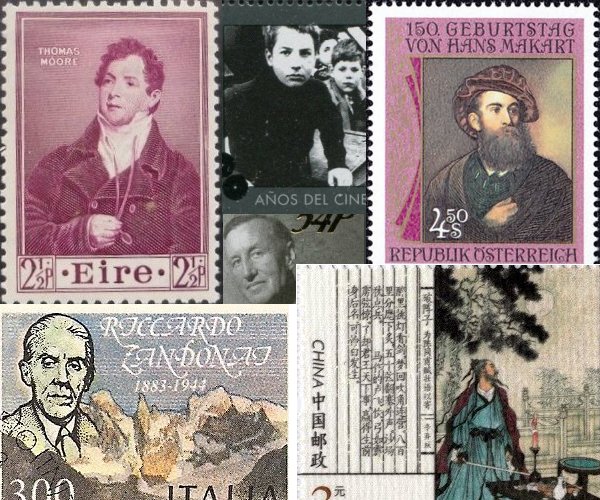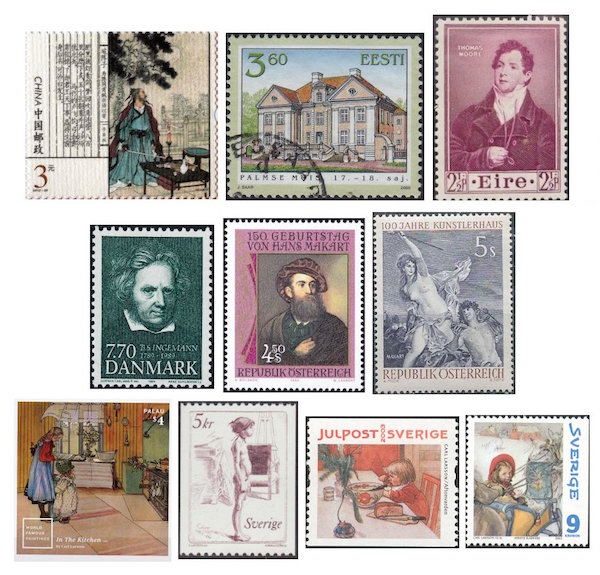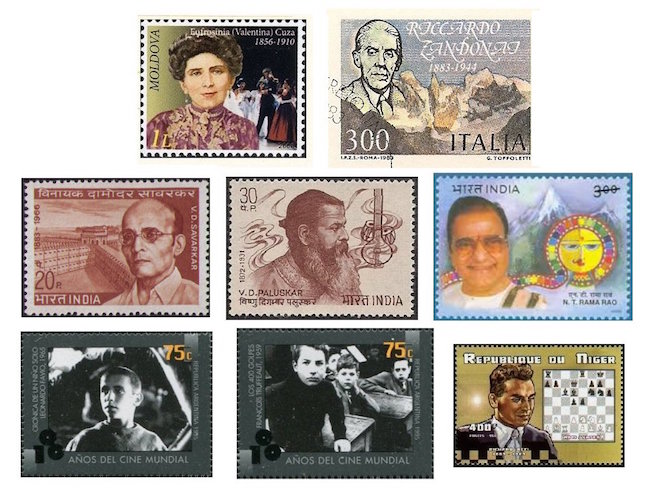The Arts on the Stamps of the World — May 28
An Arts Fuse regular feature: the arts on stamps of the world.

By Doug Briscoe
A few years ago the People’s Republic of China issued a set of stamps honoring poets of the Song dynasty (960–1279). One of these was Xin Qiji, born on this day in 1140. Most of his life was devoted to miltary matters, and all of his poems, of which 620 survive, were written after his forced retirement and political exile. He died in 1207. The stamp cites his work “This Unconstrained Poem to Chen Tongfu”.
It so happens that our next artist was also a soldier: Swedish architect and artillery commander Jacob Staël von Holstein (28 May 1628 – 2 October 1679) was a district magistrate in Estonia and, while there, designed several buildings in Toompea, the city center of Tallinn. He also built the manor house at Palmse, seen on this Estonian stamp of the year 2000. Von Holstein was killed in a duel with another major general, Gustav von Mengden, himself a poet, satirist, and composer.
Thomas Moore (1779 – 25 February 1852) is best known for his Irish Melodies, containing such famous texts as “The Minstrel Boy”, “The Last Rose of Summer”, and “Believe Me If All Those Endearing Young Charms”. His lyrics were set by many prominent and great composers, often in translation, including Berlioz, Schumann, Mendelssohn, Weber, Spontini, Duparc, and Hindemith, with English settings by Ives, Britten, Bridge, Stanford, Peter Warlock, John Ireland, Hubert Parry, William Bolcom (whose birthday was the day before yesterday, no stamp), and many others. Moore himself did compose music for some of his songs.

Danish writer Bernhard Severin Ingemann (28 May 1789 – 24 February 1862) published his first poems in 1811 while he was still a student at the University of Copenhagen. A second volume and a long allegorical poem were followed by half a dozen plays and then some stories after the manner of E.T.A. Hoffmann. Next inspired to imitate Sir Walter Scott, Ingemann wrote a series of historical novels for children, of which the first, Valdemar the Victorious (Valdemar Sejr, 1826), is perhaps the best. Finally, Ingemann also wrote a number of hymn texts that, set by Christoph Ernst Friedrich Weyse, remain popular in Denmark to this day.
Austrian painter Hans Makart (1840 – 3 October 1884) is one of those artists held in much higher regard in his own time than by posterity. He was adulated by nobility and bourgeoisie alike, and various elements of society freely intermingled in his studio cum salon. He painted historical and mythological subjects in addition to his many portraits of women. Besides painting, he also designed interiors, costumes, furniture, and pageants, most notably one in 1879 for the Silver Wedding Anniversary of the emperor Franz Josef and his wife Elisabeth, the celebrated “Makart-parade“. This was an example of his embrace of the concept articulated by his friend Richard Wagner, the Gesamtkunstwerk. The Makartstil dominated, and Gustav Klimt was one of the most deeply affected. Just to emphasize the vagaries of taste and time, Makart’s nearest rival was considered to be a gentleman by the name of Hans Canon. No, I’d never heard of him, either. Two Austrian stamps honor Makart with his work: Self-Portrait (1878) and a detail from The Triumph of Ariadne (1873-4).
For my own part, I fell in love with the works of Makart’s Swedish contemporary Carl Larsson (28 May 1853 – 22 January 1919) on visiting the Stockholm National Museum about 35 years ago. I didn’t leave the museum without buying eight post cards (I know it was eight, because I have them in my lap as I write) of Larsson’s paintings, one of which, The Kitchen (c1898) is also seen on a stamp from Palau. The charming (or pornographic, depending on your predisposition) Graziella Asking Whether She Will Do as a Model is one of several Larsson pieces found on stamps of his native Sweden. Some formed Sweden’s entire group of 2003 Christmas stamps; I show two of those, as well. Another of the paintings I acquired on a post card reproduction was The artist’s wife with daughter Suzanne (1885).

Russian dramatic soprano Eufrosinia (Valentina) Cuza (koo-ZAH) was born in Bessarabia (now Moldova) in 1856. I couldn’t find the exact date of her birth, but she died on May 28 (O.S. 5/15), 1910, so I thought I’d pay tribute to her today. She made her debut in 1894 at the Mariinsky Imperial Theatre in St. Petersburg in Meyerbeer’s Les Huguenots and remained a star of the Mariinsky for the remainder of her life. She created the rôle of Kassandra in Taneyev’s Oresteia in 1895.
Although there is (to my knowledge) no stamp honoring him, Italian composer Riccarco Zandonai (28 May 1883 – 5 June 1944) is represented here on a postal card (from which I show just the corner). He wrote opera and sacred music and some symphonic works. Francesca da Rimini is his only work that remains in the repertoire today; it was just performed at the Met in 2013.
We have no fewer than three artists from India on today’s program, and I thought we’d present them as a group. The first, chronologically speaking, Vinayak Damodar Savarkar, was born on exactly the same day as Zandonai, 28 May 1883. He’s here more because he was a poet and playwright, but his greater legacy lies in politics as a fighter for independence and for the abolishment of the caste system. He spent eleven years in prison for his revolutionary activities against the Raj. Denied pen and paper, he committed thousands of lines of poetry to memory. But again, his more noteworthy writings were such books as 1857 – The First War of Independence (1908) and My Life Sentence (Mazi Janmathep, 1949). He died on 26 February 1966.
Pandit D(attatreya) V(ishnu) Paluskar (May 28, 1921 – October 26, 1955) was a Hindustani singer of classical raga who also sang the more free form Bhajan. He was considered a child prodigy and first performed publicly at fourteen. He died of encephalitis at the age of 34.
The Indian actor and Telugu film director N(andamuri) T(araka) Rama Rao (1923 – 18 January 1996) was also prominent in politics, having served three terms as Chief Minister of Andhra Pradesh, but this was only after his career in film had come to a close. Popularly known as NTR, he starred in 300 movies besides being an editor, screenwriter, and producer. A CNN-IBN poll of 2013 found him named “Greatest Indian Actor of All Time”.
Remaining for the moment in the world of film, we turn to another all-purpose auteur (actor, film director, screenwriter), Leonardo Favio. The late Argentine filmmaker, born Fuad Jorge Jury on 28 May 1938, was at the same time also renowned as a popular singer, having released over a dozen solo albums in the 1960s and 70s. The stamp shows a still from his Crónica de un niño solo (Chronicle of a Boy Alone, 1965). (Having indelicately brought up the matter of art vs. child pornography above, I might add that this film was foolishly banned in Argentina for thirty years because it contained a scene of boys skinny dipping. You won’t find it on Netflix, either.) Favio died on 5 November 2012.

From the very same Argentine stamp set comes a picture of French actor Jean-Pierre Léaud (born 28 May 1944), seen in his signature role as Antoine Doinel, a role he undertook in five François Truffaut films between 1959 (The 400 Blows) and 1979 (Love on the Run). Léaud has certainly appeared as many other characters, having worked over the years with the likes of Jean-Luc Godard, Pier Paolo Pasolini, and Bernardo Bertolucci.
Another in our series of great chess grandmasters on stamps is the Austro-Hungarian (later Czechoslovakian) Richard Réti (28 May 1889 – 6 June 1929), noted not only as a brilliant player and composer of baffling endgame studies but, as the author of Modern Ideas in Chess (1923) and Masters of the Chess Board (1933), one of the foremost writers on the subject. The Réti Opening (1.Nf3 d5 2.c4) is named for him. His older brother Rudolph (1885–1957) was a distinguished pianist and composer. Richard Réti was only 40 when he died of scarlet fever.
It’s also the birthday of the creator of James Bond, Ian Fleming (28 May 1908 – 12 August 1964). In addition to the host of Bond stamps from around the world, there are two six-stamp sets, both dated 2008 for Fleming’s centennial, from Great Britain and Alderney. Each stamp from the UK set reproduced four book covers from one of the novels, while the Alderney group honors the man himself.
Happy birthday to Australian singer/songwriter and actress Kylie Ann Minogue (born 28 May 1968), who goes by the monomoniker Kylie in her stage persona. She worked on a hugely popular Australian soap called Neighbours (she had acted in soaps since childhood) before embarking on her solo singing career. To date she has sold over 80 million records.
May 28 is also the date of the première of the revised version of Puccini’s Madama Butterfly, 113 years ago today. The original version, in two acts, had had its initial performance just three months earlier, on 17 February 1904. Two Butterfly stamps come from Puccini souvenir sheets issued by Togo and Guinea.
I think it’s just appalling that the great Australian novelist Patrick White (28 May 1912 – 30 September 1990) hasn’t earned a stamp at some point within the last quarter century. Surely stamps for the late great György Ligeti (1923 – 12 June 2006) and Dietrich Fischer-Dieskau (1925 – 18 May 2012) will also be forthcoming. To their names we may hopefully add that of Walker Percy (1916 – May 10, 1990).
A graduate of the University of Massachusetts with a B.A. in English, Doug Briscoe worked in Boston classical music radio, at WCRB, WGBH, and WBUR, for about 25 years, beginning in 1977. He has the curious distinction of having succeeded Robert J. Lurtsema twice, first as host of WGBH’s weekday morning classical music program in 1993, then as host of the weekend program when Robert J.’s health failed in 2000. Doug also wrote liner notes for several of the late Gunther Schuller’s GM Recordings releases as well as program notes for the Boston Classical Orchestra. For the past few years he’s been posting a Facebook “blog” of classical music on stamps of the world, which has now been expanded to encompass all the arts for The Arts Fuse.
